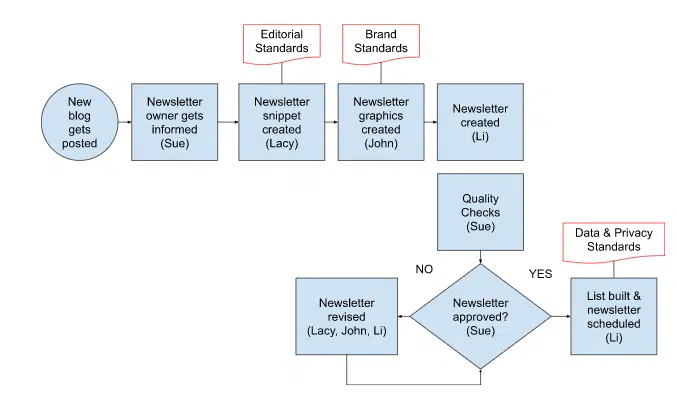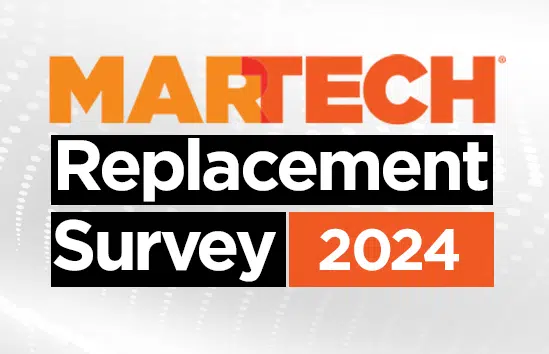In my last article, we talked about how marketing systems will change with the acceleration of AI, affecting roles, processes and workflows.
In this article, we are going to take a deeper dive into workflows, examining how AI, and specifically visual workflow builders, will impact the way marketing teams operate.
From specialists to creative technologists
Most marketing organizations rely heavily on specialists. A smaller organization may have someone who handles all of digital marketing, a larger organization typically has specialists for social media, SEO and email marketing.
An enterprise-level organization might further specialize, separating out paid vs. organic social, or even have specialists for each social media channel. The biggest change coming to marketing will be the collapse of these roles into one “creative technologist” role as AI assists with end-to-end content creation and deployment.
The merging of roles will most likely follow the trajectory set by technology. Today, separate pieces of software typically automate discrete parts of the marketing pipeline. In the near future, however, software solutions will combine to create more complete solutions.
Instead of having a separate piece of software to create a newsletter, another to create graphics and a third to deploy, one system will do it all. This will be enabled by the evolution of AI solutions such as ChatGPT 5, which has the potential to combine Sora (video), voice, DALL-E (image), search and vision in any input combination and generate any output combination of text, audio and image.
As new technologies emerge, the temptation to buy and implement the latest AI software will be great. But buyer beware. Shopping is the easy part. Marketers who implement new software without considering people and process are almost guaranteed to learn a few hard lessons along the way.
Workflows must also be considered. Current marketing workflows not only incorporate creation and deployment, but also quality checks, stakeholder alignment and revisions. With generative AI supporting the creation and deployment of marketing assets, marketers must think through the complete workflow to ensure quality and alignment are maintained.
Evaluating AI impact on workflows
One way to evaluate the impact is through process mapping, a technique that outlines each step of a process. Think of process mapping like a navigation system on steroids, outlining which direction to go and what gets done at each point along the way.
Let’s take the example of reformatting a new blog post into a newsletter blurb and deploying it. Here is how a process map of this non-automated workflow might look:


Notice how different people inform, create, perform quality checks, revise and deploy the newsletter. Each plays a vital role in getting this marketing asset to the customer.
Notice, too, the less visible steps. For example, Lacy and John know the editorial and brand standards and ensure that they are followed. Sue also knows the brand standards and serves as a final check on them. These are the types of steps that can be revealed with process mapping and must be considered when implementing AI solutions.
Dig deeper: What is marketing work management?
Moving towards more automation: Low code, no code
Many marketers already automate parts of their marketing pipeline through the likes of automated email systems, where a trigger sets off a series of activities such as a drip campaign.
Typically, the end users of these systems deal with a visual (or “no code”) interface to program the flow, relying on other individuals with “low code” capabilities to set up more advanced integrations. In the above example, Li is the most technical of the group, handling the intricacies of data and deployment of the email automation system. He may have some basic coding skills (low code) to configure the system and potentially interface with his more technical counterparts in IT. John, on the other hand, uses sophisticated graphic editing software, but doesn’t need any code to do so (“no code”).
With AI, creative technologists will engage with both no-code and low-code environments to automate more of the marketing pipeline. Visual workflow builders empower marketers by allowing system-to-system integration into a no-code visual interface. Right here is an example of how a marketer could set up an automated workflow to not only be informed of a new blog post, but to summarize the blog post into social posts, generate images and distribute the posts and images to various social platforms. Visual workflow builders provide flexibility for marketers to create any number of custom workflow scenarios.
Note that the quality checks and brand guidelines are weak in that example. Some of the automations circumvent this by putting posting the ChatGPT output into a preformatted spreadsheet with an approval column built in. Once ‘Approve’ has been selected in the spreadsheet cell, it triggers the next stage of the automation. Marketers need to monitor the brand and voice guidelines that ChatGPT has been trained on.
Note that things like stakeholder alignment and quality control are not built into the automation and still must be accounted for by humans.
How AI workflows will impact marketing jobs
The before-and-after workflows above provide a sense of how AI impacts the marketing pipeline and thus marketing roles. Marketers move from creating art, copy or campaigns from scratch to creating prompts and automations. Those who have refined prompting skills can put their creativity to use to create more and higher-level assets at scale.
Talented graphic designers can spend less time mass-producing banner ads and more time conceptualizing human and customer-centric images. Expert writers can leave converting blogs into newsletter blurbs to AI and work on connecting to their customers with emotive storytelling. Because if we all use AI to write, we all start to sound the same.
Those with a bent toward the technical can lean into automations, moving beyond no code, into more advanced, low-code ways to move marketing work from creation to the customer. Maybe, just maybe, marketers will be able to move beyond the overwhelm and into driving more top-line growth.
Marketing leaders must learn how to tap the potential of individuals and put it to work in new ways, looking for ways to increase growth, not just eliminate positions. Have coaching conversations with marketers to understand career goals and help people connect the dots to new roles. Follow the lead of companies like J.P. Morgan Chase, where all new hires (and many existing hires) get trained on prompt engineering.
Roles will evolve as workflows evolve
As AI becomes more sophisticated, the single-purpose tools of today will collapse into sophisticated, end-to-end marketing pipeline delivery systems, upending both processes and roles. Marketers can get ahead of this by using tools like process mapping to understand their current workflows, surfacing both generative and non-generative parts of the work being done.
Doing this will help them move toward automations that take into account current standards, quality checks and guardrails — and help them avoid unintended consequences. While roles are certain to evolve as workflows evolve, the future will favor those who have creative problem solving skills, who lean into data and technology, and are open to new ways of getting things done.
Contributing authors are invited to create content for MarTech and are chosen for their expertise and contribution to the martech community. Our contributors work under the oversight of the editorial staff and contributions are checked for quality and relevance to our readers. The opinions they express are their own.
























































![Key Metrics for Social Media Marketing [Infographic] Key Metrics for Social Media Marketing [Infographic]](https://www.socialmediatoday.com/imgproxy/nP1lliSbrTbUmhFV6RdAz9qJZFvsstq3IG6orLUMMls/g:ce/rs:fit:770:435/bG9jYWw6Ly8vZGl2ZWltYWdlL3NvY2lhbF9tZWRpYV9yb2lfaW5vZ3JhcGhpYzIucG5n.webp)



















